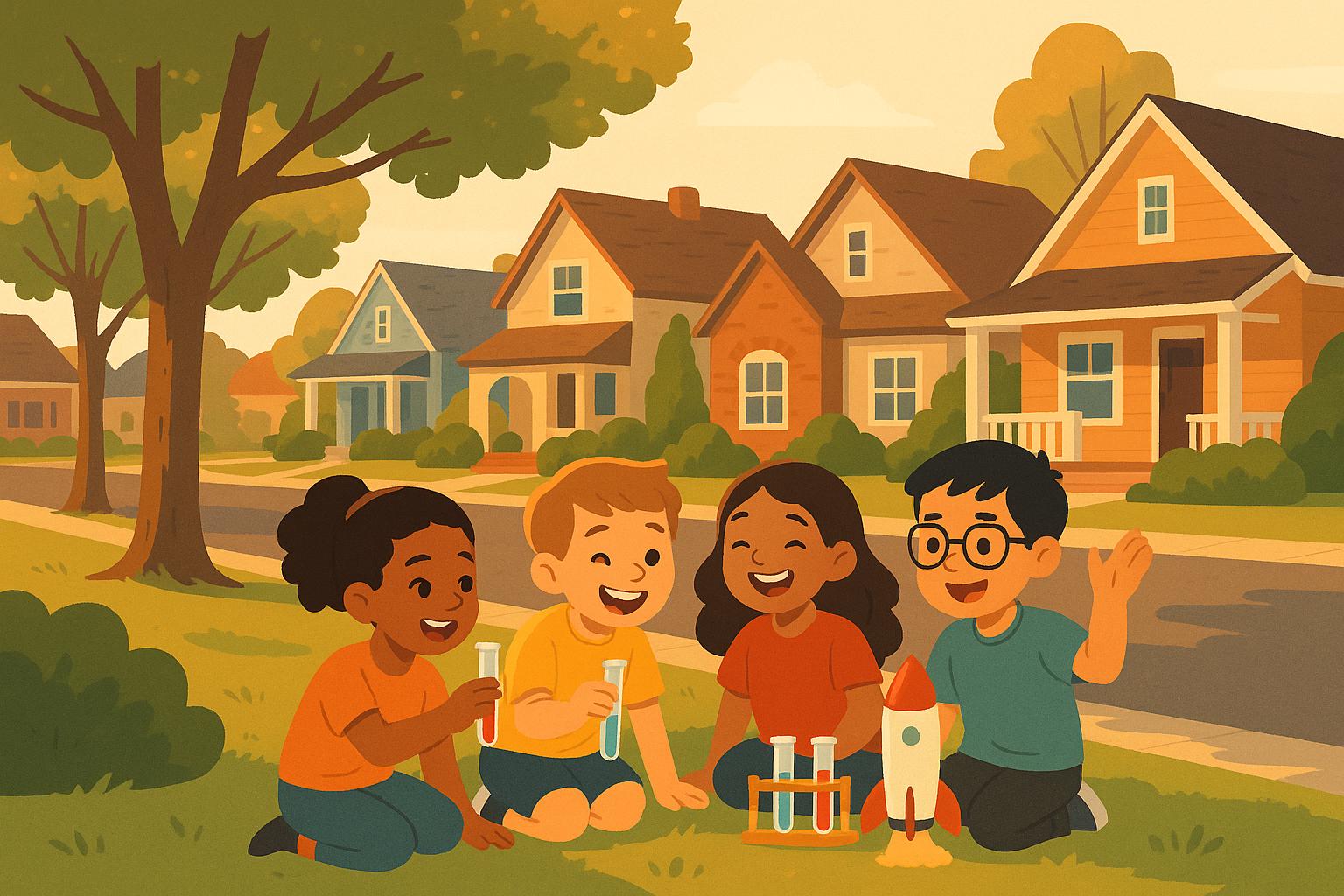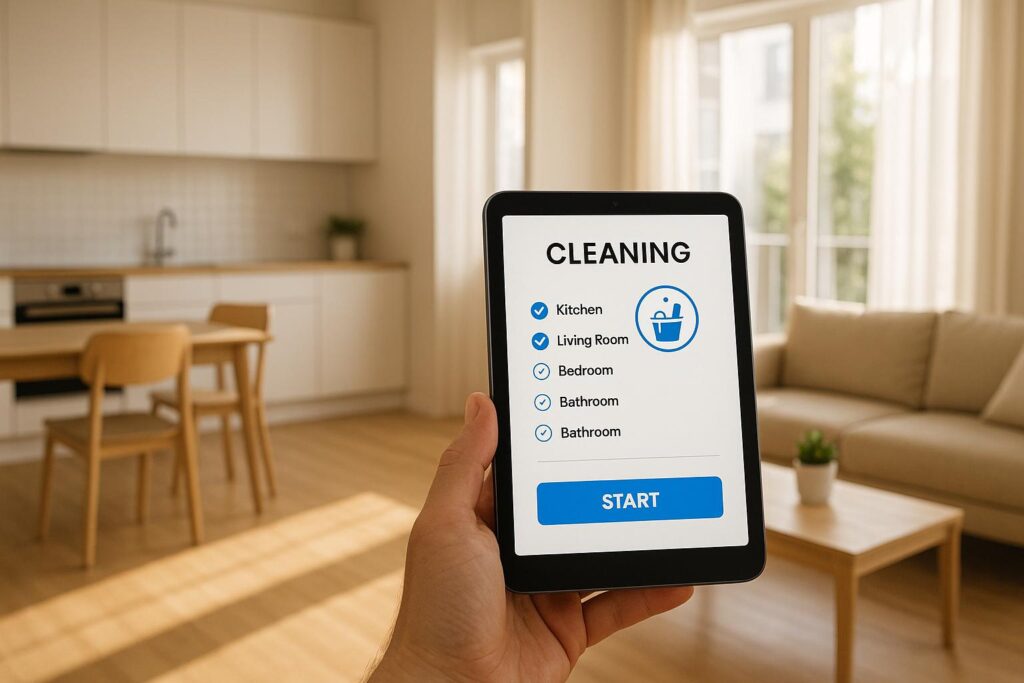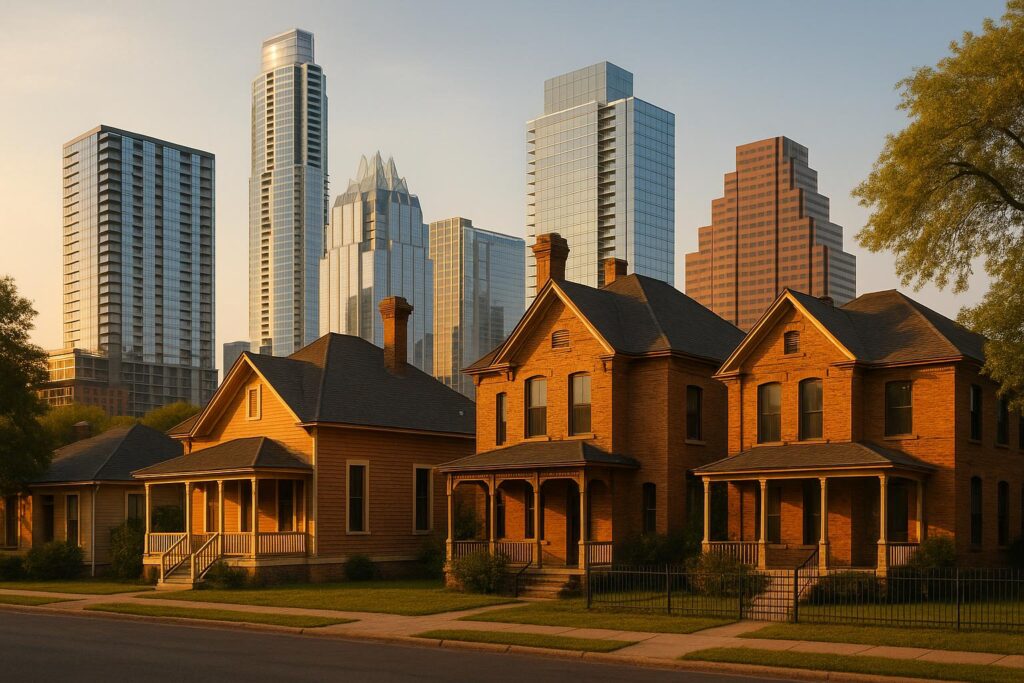Private STEM schools in Austin’s suburbs are shaping home-buying decisions for families prioritizing education. This article explores the top suburbs offering excellent STEM programs, small class sizes, and strong connections to Austin’s tech industry. Here’s a quick summary:
- West Lake Hills: Advanced robotics, AI, and engineering programs. Tuition: $22,000–$28,500.
- Lake Travis/Bee Cave: Marine biology, aerospace, and environmental science. Tuition: $19,500–$25,000.
- North Austin/Cedar Park: Early STEM focus with computer science and maker spaces. Tuition: $16,500–$22,000.
- Central Austin/Hyde Park: Biotechnology, digital arts, and physics labs. Tuition: $20,000–$26,500.
- Round Rock/Pflugerville: Affordable options with robotics and coding academies. Tuition: $15,000–$21,000.
Quick Comparison:
| Suburb | Average Class Size | Tuition Range (2024-25) | Grade Levels | Key STEM Programs |
|---|---|---|---|---|
| West Lake Hills | 12-15 students | $22,000 – $28,500 | K-12 | Robotics, Engineering, AI Programming |
| Lake Travis/Bee Cave | 15-18 students | $19,500 – $25,000 | PreK-12 | Marine Biology, Aerospace |
| North Austin/Cedar Park | 16-20 students | $16,500 – $22,000 | K-8 | Computer Science, Maker Spaces |
| Central Austin/Hyde Park | 14-16 students | $20,000 – $26,500 | PreK-12 | Biotechnology, Digital Arts |
| Round Rock/Pflugerville | 18-22 students | $15,000 – $21,000 | K-12 | Coding, Robotics |
These suburbs combine strong STEM programs with family-friendly communities, making them ideal for families seeking quality education and vibrant neighborhoods.
Top Public & Private Schools in Central Texas Revealed
How We Ranked the Suburbs
Our rankings focus on how well each suburb’s STEM programs meet the needs of local families. We looked at school performance, the quality of STEM curriculums, and how well graduates fare after leaving school.
Key Academic Indicators
- Small class sizes with low student-to-teacher ratios
- Availability of AP and IB STEM courses
- Math and science standardized test scores
- STEM-related extracurriculars, like clubs and activities
Quality of STEM Programs
- Up-to-date lab facilities and modern tech resources
- Access to robotics and coding programs
- Partnerships with local tech companies for research opportunities
- STEM teachers with strong credentials and experience
Here’s how we broke down the evaluation:
| Evaluation Category | Weight | Key Metrics |
|---|---|---|
| Academic Performance | 35% | Test scores, AP/IB participation rates |
| STEM Infrastructure | 25% | Lab facilities, modern tech resources |
| Faculty Qualifications | 20% | Advanced degrees, industry experience |
| Student Outcomes | 20% | College acceptance rates, competition results |
Graduate Success Factors
- Acceptance into top-tier engineering and science programs
- STEM scholarships earned by students
- Wins at science fairs and robotics competitions
- Internship opportunities with Austin-based tech companies
Each criterion was weighted based on its impact on student success. By analyzing past performance data, we ensured these rankings reflect both current strengths and long-term stability in STEM education. This thorough approach highlights suburbs offering strong educational opportunities.
Next, we’ll explore how private STEM schools are performing in these suburbs.
Private STEM Schools in Austin Area
Let’s take a closer look at the standout features of some of the top private STEM schools in Austin’s suburbs. These schools have prioritized modern facilities and specialized STEM programs, offering students unique opportunities to excel.
Modern Learning Facilities
Private STEM schools in Austin are known for their advanced facilities, which often include:
- Innovation labs with 3D printers, laser cutters, and interactive workspaces
- High-tech computer labs geared for programming and software development
- Robotics workshops and makerspaces for hands-on projects
- Professional-grade science labs for experiments and research
Specialized STEM Tracks
These schools provide a variety of STEM-focused programs tailored to different areas of interest:
| Program Type | Features | Grade Levels |
|---|---|---|
| Engineering Focus | CAD tools, robotics, and engineering projects | 6-12 |
| Computer Science | Programming, app development, cybersecurity | 7-12 |
| Life Sciences | Bio labs, medical programs, research opportunities | 9-12 |
| Mathematics | Advanced calculus, statistics, data science | 6-12 |
These specialized tracks are often enhanced by collaborations with professionals in the field.
Connections to Austin’s Tech Industry
Many schools work closely with Austin’s thriving tech sector to provide students with real-world experience. These partnerships include:
- Mentorship programs with industry experts
- Access to corporate research spaces
- Summer internships at tech companies
- Guest lectures by leaders in technology
- Collaborative research and development projects
Additional Student Resources
To help students succeed, these schools offer a range of support services, such as:
- Personalized STEM tutoring
- College counseling focused on STEM pathways
- Databases for research opportunities
- Training for STEM competitions
- Access to professional-grade software and tools
Small Classes and Individual Attention
Private STEM schools in Austin also stand out for their small class sizes, which foster personalized learning:
| Grade Level | Average Class Size | Student-Teacher Ratio |
|---|---|---|
| Elementary (K-5) | 15-18 students | 12:1 |
| Middle School (6-8) | 16-20 students | 14:1 |
| High School (9-12) | 18-22 students | 15:1 |
With a focus on hands-on projects and real-world applications, these schools combine academic rigor with innovative teaching methods to prepare students for STEM careers.
1. West Lake Hills
West Lake Hills offers families access to schools with a strong focus on STEM education, thanks to its close ties to Austin’s thriving tech industry.
Private schools in this area incorporate STEM into their programs through practical, hands-on projects. They also partner with tech companies to provide students with opportunities to learn beyond the classroom.
Activities like coding workshops, robotics clubs, and mentorship programs complement the curriculum, helping students build skills for future STEM careers. These features make West Lake Hills stand out in Austin’s STEM education scene.
In addition to excellent academics, families enjoy a welcoming community. For housing information, check out resources from Austin Local Team.
2. Lake Travis/Bee Cave
The Lake Travis/Bee Cave area stands out for its focus on STEM education, setting it apart from central Austin. Families here benefit from a range of programs and partnerships designed to nurture children’s interest in science, technology, engineering, and mathematics.
Community organizations and public institutions regularly host STEM-focused events and workshops. These activities not only support private school programs but also inspire kids to explore STEM fields further. Together, these efforts align with the educational and lifestyle priorities of families in the area.
If you’re considering moving closer to these educational hubs, the Austin Local Team provides detailed market analysis and property recommendations tailored to family-friendly living.
3. North Austin/Cedar Park
North Austin and Cedar Park stand out as great options for families looking for strong STEM programs without the higher living costs of central Austin. Private schools in these areas focus on challenging curricula that mix theoretical learning with practical, hands-on experiences. Beyond the classroom, local communities host organized STEM events and provide accessible public spaces that encourage students to stay involved and curious. This combination of quality education, affordability, and community support makes these suburbs an appealing choice for families prioritizing STEM-focused opportunities.
sbb-itb-4c99469
4. Central Austin/Hyde Park
Hyde Park is a neighborhood with a mix of historic charm and modern living. From classic bungalows to sleek condominiums, it offers housing options that appeal to families looking to be near private STEM schools. Local experts, such as the Austin Local Team, play a key role in helping families navigate the area. Their knowledge of school zones, property values, and neighborhood features makes it easier for families to find a home that fits their needs while staying close to quality STEM-focused education in this well-established Central Austin community.
5. Round Rock/Pflugerville
Round Rock and Pflugerville are popular among families seeking private STEM education in a suburban environment. These areas provide plenty of opportunities for STEM learning while fostering a sense of community.
Some local programs and events include:
- STEM fairs and robotics competitions held annually
- Coding workshops at local libraries on weekends
- Community maker spaces and tech labs
- Science-themed summer camps and after-school programs
These hands-on experiences go beyond the classroom, giving kids a chance to dive into STEM fields while enjoying a family-friendly atmosphere. The combination of educational opportunities and community-focused activities makes Round Rock and Pflugerville appealing for families aiming to nurture their children’s technical skills.
School Comparison by Suburb
Here’s a breakdown of private STEM schools in Austin’s top suburbs, comparing class sizes, tuition, grade levels, and STEM program focus.
| Suburb | Average Class Size | Tuition Range (2024-25) | Grade Levels | Key STEM Programs |
|---|---|---|---|---|
| West Lake Hills | 12-15 students | $22,000 – $28,500 | K-12 | Advanced Robotics, Engineering Lab, AI Programming |
| Lake Travis/Bee Cave | 15-18 students | $19,500 – $25,000 | PreK-12 | Marine Biology, Environmental Science, Aerospace |
| North Austin/Cedar Park | 16-20 students | $16,500 – $22,000 | K-8 | Computer Science, Mathematics Academy, Maker Space |
| Central Austin/Hyde Park | 14-16 students | $20,000 – $26,500 | PreK-12 | Biotechnology, Digital Arts, Physics Lab |
| Round Rock/Pflugerville | 18-22 students | $15,000 – $21,000 | K-12 | Robotics Club, Coding Academy, Engineering Projects |
West Lake Hills stands out with its focus on robotics, engineering, and AI. Lake Travis/Bee Cave offers programs in marine biology, environmental science, and aerospace. North Austin/Cedar Park emphasizes early STEM education with computer science, math, and maker activities. Central Austin/Hyde Park highlights biotechnology, digital arts, and physics. Round Rock/Pflugerville provides affordable options with strong robotics, coding, and engineering programs.
After-school STEM activities also play a role in what sets each suburb apart.
| Suburb | Activities Offered | Weekly Hours | Student-to-Instructor Ratio |
|---|---|---|---|
| West Lake Hills | Robotics, Coding, Science Lab | 12-15 | 8:1 |
| Lake Travis/Bee Cave | Environmental Club, Tech Workshop | 10-12 | 10:1 |
| North Austin/Cedar Park | Math Club, Engineering Projects | 8-10 | 12:1 |
| Central Austin/Hyde Park | Biotech Lab, Digital Design | 10-14 | 9:1 |
| Round Rock/Pflugerville | Coding Club, Robotics Team | 8-12 | 12:1 |
These comparisons can help match your child’s STEM interests with the right school. Visiting schools in person can provide a clearer picture of their offerings and environment.
Living Near Top STEM Schools
Living close to top private STEM schools can increase property values and foster a strong sense of community. These neighborhoods often host local events, educational workshops, and family-friendly programs that bring people together.
The benefits of these schools go beyond academics – they enhance the surrounding community as well. Finding a home near one of these schools means balancing education quality with real estate considerations. The Austin Local Team simplifies this process by offering services like tailored agent matching, focused property searches, in-depth neighborhood insights, listing updates, and relocation assistance.
Here’s how the Austin Local Team can help:
- Tailored agent matching with expertise in school districts
- Targeted property searches within specific school zones
- Detailed neighborhood insights to help you make informed decisions
- Alerts for new listings in your preferred districts
- Comprehensive relocation services to make your move easier
Living near top STEM schools often encourages active community participation, creating a dynamic environment enriched by educational events and workshops that benefit everyone.
Additionally, homes in these areas tend to hold their value and show consistent appreciation, making them a smart choice for families seeking both educational and financial advantages.
Summary
Our analysis shows that Austin’s suburbs blend excellent private STEM education with vibrant communities. These areas provide a mix of housing options and well-regarded STEM programs.
Whether it’s established neighborhoods like West Lake Hills and Lake Travis or growing areas such as Cedar Park and Round Rock, each suburb prioritizes STEM-focused education while maintaining strong community ties.
This mix of academic quality and community benefits makes these suburbs a smart choice for families focused on both education and lifestyle. The pairing of strong STEM programs with welcoming neighborhoods highlights why these areas are great for families seeking well-rounded opportunities.
FAQs
What should families look for when choosing a suburb in Austin with private STEM schools?
When selecting a suburb in Austin for private STEM education, families should evaluate factors like the quality of local schools, proximity to work or other daily activities, and the overall neighborhood vibe. Consider whether the area offers amenities that align with your family’s lifestyle, such as parks, community centers, or extracurricular opportunities.
Additionally, understanding the local housing market is key. Partnering with experts who know Austin’s neighborhoods can help you find a home that fits both your budget and educational priorities. This ensures a smooth transition to a community that supports your family’s academic and personal goals.
How do local tech company partnerships improve STEM programs in Austin’s suburban private schools?
Partnerships with local tech companies play a key role in enhancing STEM programs in Austin’s suburban private schools. These collaborations often provide students with access to cutting-edge technology, mentorship opportunities from industry professionals, and real-world applications of STEM concepts. For example, students may participate in hands-on projects, coding workshops, or internships that deepen their understanding and prepare them for future careers in science and technology.
These partnerships also benefit schools by keeping their STEM curricula aligned with current industry trends and innovations. Families in these suburbs can feel confident that their children are gaining skills and experiences that are both practical and future-focused, making these schools an excellent choice for STEM education.
What are the advantages of living near top private STEM schools in Austin for families and property values?
Living near top private STEM schools in Austin offers several benefits for families and homeowners. For families, these schools provide access to high-quality, specialized education in science, technology, engineering, and math, helping to foster academic excellence and preparing students for future career opportunities. Proximity to these schools can also reduce commute times, giving families more time to spend together.
From a property value perspective, homes near renowned private STEM schools are often in high demand, which can lead to increased property values over time. These areas also tend to attract vibrant, family-friendly communities, creating a welcoming environment for residents. Choosing to live near these schools can be a smart investment for both your family’s education and your home’s long-term value.





